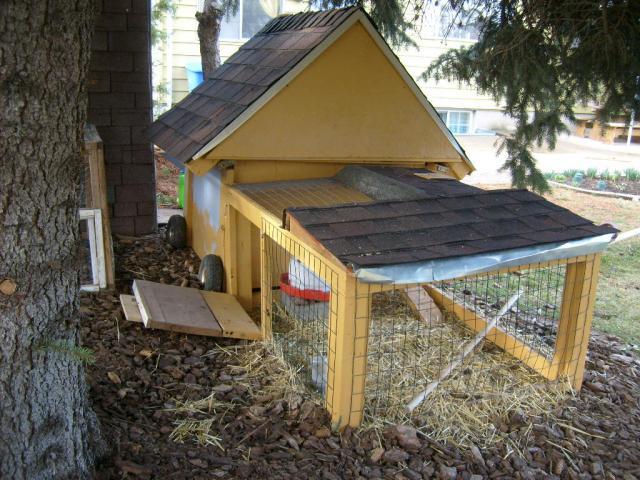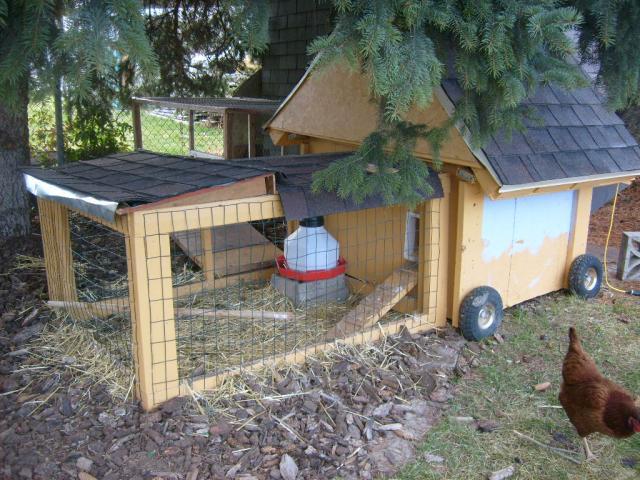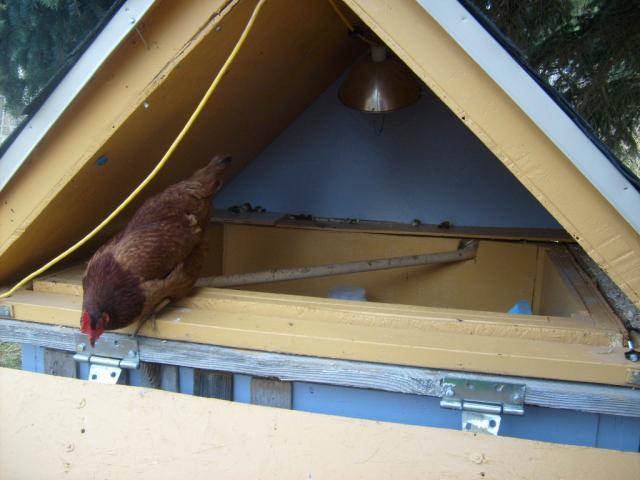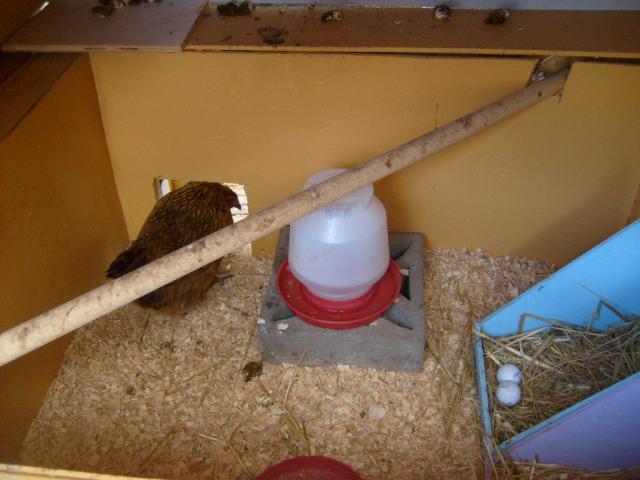- Mar 18, 2011
- 22
- 0
- 22
So, I bought this coop out of the local classifieds over the weekend. I've had it for 2 days. I bought it because it came with 5 laying hens, all their gear and 2 runs for $200. For that price, I decided I could modify the coop as needed. Now I'm looking for any helpful ideas from all you great coop builders out there. I have minimal carpentry skills, (but my husband has a slightly better handy streak) and I'm trying to keep costs down. I'll start with pictures, followed by my opinion of problem spots and ideas I have for fixing them. I'd love to hear your honest feedback! Thanks!




Ok-here are some basic measurements: (the coop is super insulated on all sides and in the roof, hence the thick walls.)
Interior room: 3.5 feet wide, 2 feet, 8 inches long, 19.5 inches deep. (The floor is raised 11.5 inches off the ground) This makes for 8.75 square feet of floor space.
A frame roof space: at 19.5 inches high, there is a sort of shelf all around the room from the insulated walls. The roof (which would be detachable if I had Herculean strength) sits on a shelf all around the walls, making the interior shelf 8 inches wide on the side where the A part of the roof is, and 7.5 inches and 5.5 inches wide on the sides where the sloping part of the roof is.)
So, the height of the triangle made by the roof is 26 inches and the width is about 4.5'. One of the hens roosts on the 8 inch shelf opposite the roof 'door' (where you see all the poo in the picture.) Otherwise, I don't notice anyone using the shelves.
There is a heat lamp rigged into the roof area.
The attached run is about 4' by 5'. It is 3/4 of the way covered with shingled roofing. I have buried paving stones under the bark chips around the run to try to discourage digging predators.
Here are the problems:
1) NO VENTILATION in the coop. None. nada. nix. (unless you count the doorless pop door, which brings me to #2)
2) NO DOOR for the pop door.
3) Roost dowel is on the thin side, and I don't like it's positioning.
4) the wire in the run is raccoon friendly.
5) The chickens (with the exception of the one hen who roosts on the 8 inch shelf) don't use the coop. They stay in the run, except to have a bite to eat. (I keep the food and a small waterer in the coop) Two hens are laying in the nest boxes, but the other three are laying in a self made 'nest' in the run. I'm thinking the no ventilation thing has a big part to play with the hens not using the coop. The one hen who does use the coop is recovering from frostbitten toes she got when she was trapped suspended in the air (wedged between the house and the feed box) at her old place overnight, so she probably prefers stuffy to frigid. (P.S. I'm taking good care of her frostbite-done lots of research, chatted with experienced BYC'ers, etc. I'm looking for COOP advice on this thread. Thanks.)

OK. Here are my ideas for solutions:
1)My husband picked up a couple 6 by 16 inch vent covers today, and we're thinking we'll cut ventilation holes in the upper part of the A parts of the roof and slap those vent covers on for a quick 'emergency' fix. Only concern is that these vents will only be about 14 inches above where my little invalid roosts. Is that gonna be too chilly for her? (We're still getting below freezing temps here in Utah)
We are tossing around the idea of building an extension of the coop over the run-probably just half way over the run. We'd take the A part of the roof off, and add a box shaped addition approximately 2.5' by 4' big and 26" tall. We could get away without sloping that part of the roof because we have our coop positioned under a super thick, tall pine tree that doesn't let snow and the rare rain we get out here through it's branches. We're thinking we could move the nest boxes up there, plus build in lots of ventilation (like have the whole far wall be hardware cloth with a wooden wall with a smaller vent slot build in that we could attach for the winter months , and having one of the other 2 sides be half hardware cloth with flaps to close in the winter, and the last side we'll install an old glass window that can slide open (we'll cover the opening with hardware cloth). That way there's some natural light let into the coop in the winter when the windows are shut) Maybe put the food and water up there too.
That would leave the original coop area for roosting space (I'd like to try a sort of roost latter with 2 by 4's. I'd have at least one of the 2x4's with the 4 side up for my frost bite victim, who will likely lose 5 of her 8 toes.)
Finally, we'll add another large widow with a flap on the remaining A side of the roof.
I hope all that makes sense to someone out there!
2) Once the emergency vents are in place, add a flap door to the pop door and begin shutting the chickens into the coop for the night. (Or is it really ok to let them have 24/7 access to their little run out there? It just feels like I ought to lock 'em tight at night.
3) I plan on making the before mentioned roosting ladder when I have added more space to the coop.
4) Replace the wire in the run with 1/2 inch hardware cloth. Use the old wire to make a 'skirt' for the run to more effectively protect against digging predators.
5) hope the adjustments we've made entice the chickens to enjoy our hard work.

Just so you have an idea of the chicken's freedom level: I let them free range in yard when we're outside to supervise them. (We're usually out at least a couple times a day-I'm a stay at home mom with young children-we all need a breath of fresh air periodically)
 Otherwise, they're in the coop and run.
Otherwise, they're in the coop and run.
Thanks for persevering through this long and technical post! I hope it's clear enough to understand. Let me know what you think of our plans or if you have any other ideas. Thanks!




Ok-here are some basic measurements: (the coop is super insulated on all sides and in the roof, hence the thick walls.)
Interior room: 3.5 feet wide, 2 feet, 8 inches long, 19.5 inches deep. (The floor is raised 11.5 inches off the ground) This makes for 8.75 square feet of floor space.
A frame roof space: at 19.5 inches high, there is a sort of shelf all around the room from the insulated walls. The roof (which would be detachable if I had Herculean strength) sits on a shelf all around the walls, making the interior shelf 8 inches wide on the side where the A part of the roof is, and 7.5 inches and 5.5 inches wide on the sides where the sloping part of the roof is.)
So, the height of the triangle made by the roof is 26 inches and the width is about 4.5'. One of the hens roosts on the 8 inch shelf opposite the roof 'door' (where you see all the poo in the picture.) Otherwise, I don't notice anyone using the shelves.
There is a heat lamp rigged into the roof area.
The attached run is about 4' by 5'. It is 3/4 of the way covered with shingled roofing. I have buried paving stones under the bark chips around the run to try to discourage digging predators.
Here are the problems:
1) NO VENTILATION in the coop. None. nada. nix. (unless you count the doorless pop door, which brings me to #2)
2) NO DOOR for the pop door.
3) Roost dowel is on the thin side, and I don't like it's positioning.
4) the wire in the run is raccoon friendly.
5) The chickens (with the exception of the one hen who roosts on the 8 inch shelf) don't use the coop. They stay in the run, except to have a bite to eat. (I keep the food and a small waterer in the coop) Two hens are laying in the nest boxes, but the other three are laying in a self made 'nest' in the run. I'm thinking the no ventilation thing has a big part to play with the hens not using the coop. The one hen who does use the coop is recovering from frostbitten toes she got when she was trapped suspended in the air (wedged between the house and the feed box) at her old place overnight, so she probably prefers stuffy to frigid. (P.S. I'm taking good care of her frostbite-done lots of research, chatted with experienced BYC'ers, etc. I'm looking for COOP advice on this thread. Thanks.)

OK. Here are my ideas for solutions:
1)My husband picked up a couple 6 by 16 inch vent covers today, and we're thinking we'll cut ventilation holes in the upper part of the A parts of the roof and slap those vent covers on for a quick 'emergency' fix. Only concern is that these vents will only be about 14 inches above where my little invalid roosts. Is that gonna be too chilly for her? (We're still getting below freezing temps here in Utah)
We are tossing around the idea of building an extension of the coop over the run-probably just half way over the run. We'd take the A part of the roof off, and add a box shaped addition approximately 2.5' by 4' big and 26" tall. We could get away without sloping that part of the roof because we have our coop positioned under a super thick, tall pine tree that doesn't let snow and the rare rain we get out here through it's branches. We're thinking we could move the nest boxes up there, plus build in lots of ventilation (like have the whole far wall be hardware cloth with a wooden wall with a smaller vent slot build in that we could attach for the winter months , and having one of the other 2 sides be half hardware cloth with flaps to close in the winter, and the last side we'll install an old glass window that can slide open (we'll cover the opening with hardware cloth). That way there's some natural light let into the coop in the winter when the windows are shut) Maybe put the food and water up there too.
That would leave the original coop area for roosting space (I'd like to try a sort of roost latter with 2 by 4's. I'd have at least one of the 2x4's with the 4 side up for my frost bite victim, who will likely lose 5 of her 8 toes.)
Finally, we'll add another large widow with a flap on the remaining A side of the roof.
I hope all that makes sense to someone out there!
2) Once the emergency vents are in place, add a flap door to the pop door and begin shutting the chickens into the coop for the night. (Or is it really ok to let them have 24/7 access to their little run out there? It just feels like I ought to lock 'em tight at night.
3) I plan on making the before mentioned roosting ladder when I have added more space to the coop.
4) Replace the wire in the run with 1/2 inch hardware cloth. Use the old wire to make a 'skirt' for the run to more effectively protect against digging predators.
5) hope the adjustments we've made entice the chickens to enjoy our hard work.

Just so you have an idea of the chicken's freedom level: I let them free range in yard when we're outside to supervise them. (We're usually out at least a couple times a day-I'm a stay at home mom with young children-we all need a breath of fresh air periodically)

Thanks for persevering through this long and technical post! I hope it's clear enough to understand. Let me know what you think of our plans or if you have any other ideas. Thanks!


